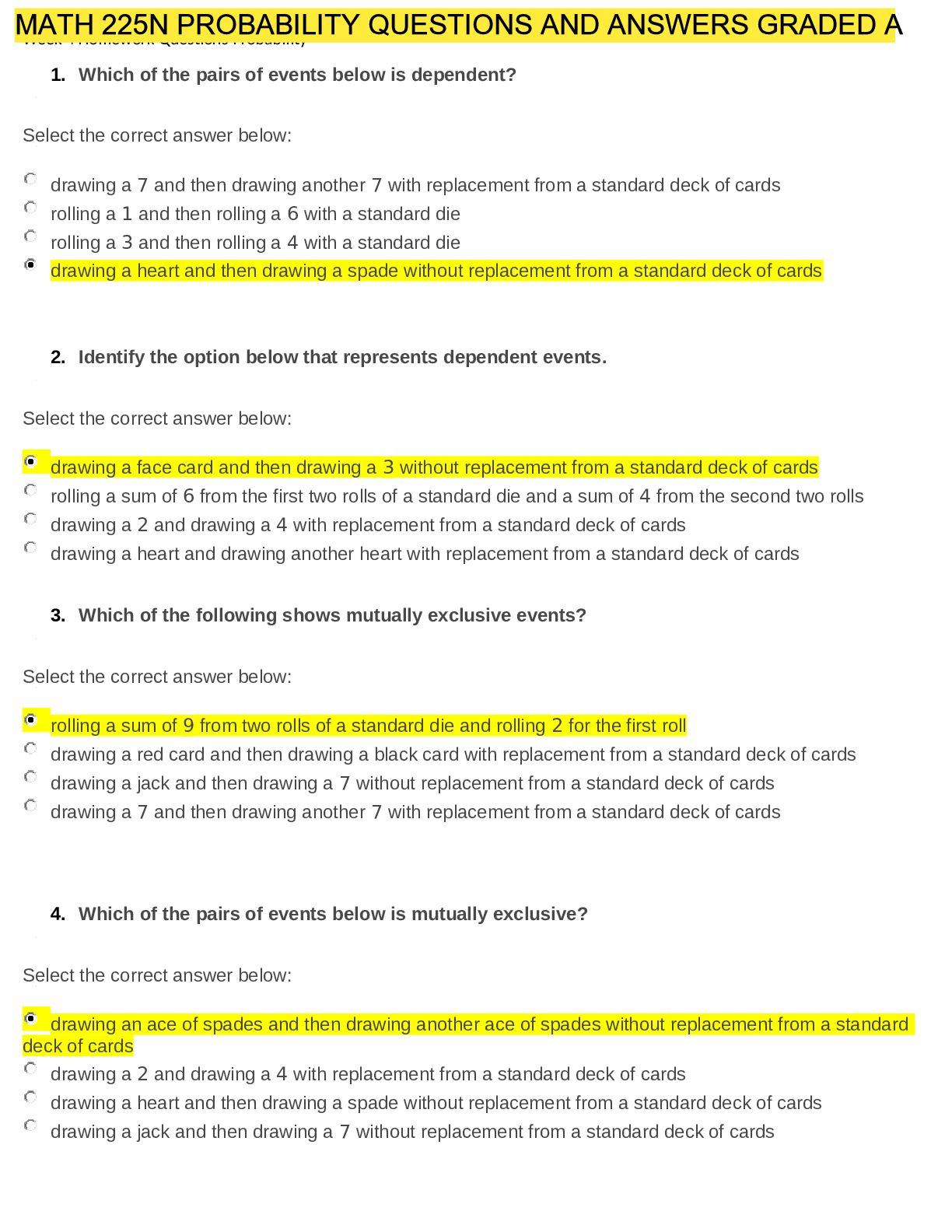*NURSING > QUESTIONS & ANSWERS > HLT 306V Week 4 Topic 4 Homework Questions and Answers;Latest 2022;Complete Work (All)
HLT 306V Week 4 Topic 4 Homework Questions and Answers;Latest 2022;Complete Work
Document Content and Description Below
1 Running head: HOMEWORK TOPIC 4 Homework Topic 4 Austin Hargrove Grand Canyon University HLT 306v This study source was downloaded by 100000831988016 from CourseHero.com on 05-03-2022 05:52:02 ... GMT -05:00 https://www.coursehero.com/file/56194468/Homework-Topic-4docx/ 2 HOMEWORK TOPIC 4 Homework Topic 4 Define negotiation as it applies to patient education Negotiation in health care is a critical component of patient education. It is used to help providers and patients decide and agree on care plans. Health care professionals have a duty to the patient to make sure they understand their illness or condition and know how to do their part in the treatment plan. If we don’t negotiate, “we open the door to the possibility of nonadherence and poor outcomes” (Falvo, 2011). Explain how the change in the patient's status through the years has affected patient education Patient status has changed through education over the years. “Provider interaction with the patient must be enthusiastic, motivating, and responsive to each patient’s individual need” (Paterick, Patel, Tajik, and Chandrasekaran, 2017). Patients are now expected to play a part in their health care. In the past, the providers were the only ones with say so. Providers must take the time to educate so individuals can feel empowered by contribution. “The responsibility has shifted from the healthcare team alone to both provider and the patient” (Falvo, 2011). List the pros and cons of negotiation Negotiation has pros and cons. Pros consist of patients adhering to treatment plans, patients become actively involved in their care, and increased outcome improvement. Cons consist of failure to find a mutual agreement between provider and patient and poor relationship between patient and provider. “Negotiation can create friction between the two parties leaving no resolution” (Falvo, 2011). Describe the general conditions that would be included in a patient contract This study source was downloaded by 100000831988016 from CourseHero.com on 05-03-2022 05:52:02 GMT -05:00 https://www.coursehero.com/file/56194468/Homework-Topic-4docx/ 3 HOMEWORK TOPIC 4 “Patient contracts are used to set measurable goals” (Falvo, 2011). If we have measurable goals, patient adherence increases. Contracts have steps for patients to follow regarding participation in their treatment. The contract needs to be individualized for each patient while including their support team or adjusting for lack of. If at any time the situation changes, the contract must change as well. Communication is a huge factor and imperative that provider and patient followup with one another. Discuss old age and the baby boomer Baby boomers are those born 1946-1964, make up a for a large part of our population, and are also part of the aging population. People are living longer, and the baby boomers are retiring. Old age brings multiple considerations for one to reflect on. Can they take care of themselves; can they survive with change in income or health coverage, and is there a support system in place? “Technology and medicine have advanced, so we can better accommodate the aging adult” (Falvo, 2011). List several generational, religious, and cultural differences between the 30-year-old health care professional and the elderly patient Elderly patients and the average 30-year-old provider have the potential to see things differently. The elderly grew up in a different time, and may possess a different outlook on things. Culture is continuously changing. Elderly patients may find frustration with the increasing changes in trends and lifestyle, especially when it comes to technology in healthcare. We must be respectful and mindful that they come from a simpler time vs all the grey that exists now. Younger providers use current technology and the elderly patient is more “old school,” they’re not as open to change, especially when it comes to introducing technology in place of things they are used to having people do. “Religion will also be viewed more seriously” (Falvo, 2011). This study source was downloaded by 100000831988016 from CourseHero.com on 05-03-2022 05:52:02 GMT -05:00 https://www.coursehero.com/file/56194468/Homework-Topic-4docx/ 4 HOMEWORK TOPIC 4 Explain some of the barriers to patient education of the elderly and discuss their special needs Barriers to elderly patients education include; cognitive changes, hearing and vision impairment. All elderly are not the same, as we as healthcare workers know. We must not make assumptions when it comes to elderly patients. Many elderly people are very self-sufficient, but we must continue to reassess as changes occur with age. “A case by case method is best as each person has different needs at different times” (Falvo, 2011). List ways to best approach patient education of the elderly The best approach for older adult education depends on the individual. We need to know familial status, living arrangements, disabilities, and ca [Show More]
Last updated: 2 years ago
Preview 1 out of 6 pages

Buy this document to get the full access instantly
Instant Download Access after purchase
Buy NowInstant download
We Accept:

Reviews( 0 )
$10.00
Can't find what you want? Try our AI powered Search
Document information
Connected school, study & course
About the document
Uploaded On
May 03, 2022
Number of pages
6
Written in
Additional information
This document has been written for:
Uploaded
May 03, 2022
Downloads
0
Views
100

.png)














